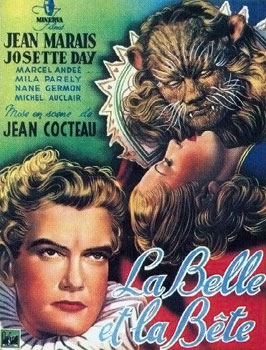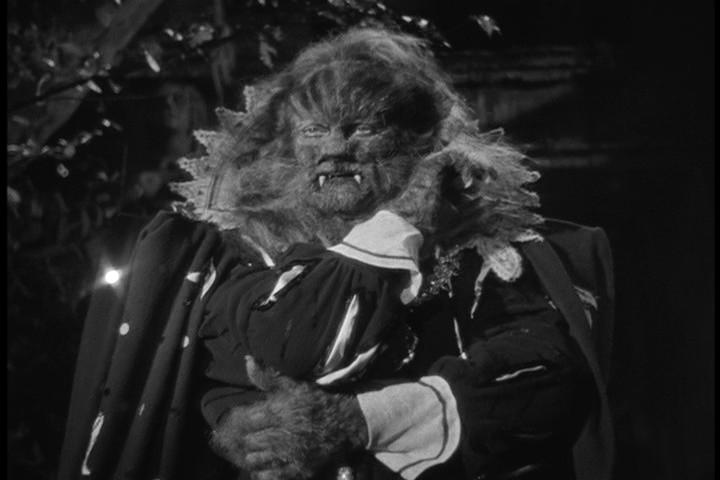The plot of Cocteau's film revolves around Belle's father who is sentenced to death for picking a rose from Beast's garden. Belle offers to go back to the Beast in her father's place. Beast falls in love with her and proposes marriage on a nightly basis which she refuses. Belle eventually becomes more drawn to Beast, who tests her by letting her return home to her family and telling her that if she doesn't return to him within a week, he will die of grief.
An interesting note to take, as mentioned by Michael Wilmington is that; "this film was made during the Nazi occupation under hard conditions -- at a time when French film artists more easily spoke their minds while hiding behind legends or tales of the past. And we feel the weight of oppression on the film." (Wilmington, 2002) With this in mind we can see the relatable oppression Belle suffered alongside the current events of their time. A story about escaping from a bad life.
Fig. 1 La Belle et la Bête (1946)
For its time, the set and costume design are truly beautiful and magical. First of all, Jean Marias who not only played the role of Belle's jealous suitor, Avenant, but also the Beast himself. What was truly remarkable about this, is that you honestly couldn't tell it was him. As we are a generation who rely heavily on CGI to transform people, this transformation for Marias, who was under layers of hair and make up, and forced to act with his limited expressions is a phenomenal achievement. As Tim Brayton addresses in his review; "I shall run the risk of hyperbole, and claim that the beast mask is the single greatest make-up effect of all time - if not necessarily the most strictly realistic, surely the most magnificent in effect, frightening us and seducing us in one breath, begging to be touched as much as anything in any film ever has been" (Brayton, 2008)
Fig. 2 La Belle et la Bête (1946)
The set designs too need to be applauded. The Beast's castle, filled with extravagant decors but still somewhat very simple, also had the enchanted touch to it. The one that stands out the most would have to be the floating arms holding candelabras that would stretch out as you walk down the hallway. As Sean. P. Means describes; "Cocteau didn't just interpret a fairy tale with this black-and-white wonder, but re-created a fairy-tale world. His Beast's castle is a shadowy place, where living human arms jut out from the walls to hold candles and open curtains. Candles light by themselves, and gorgeous strands of pearls appear as if by magic." (Means, 2007). Although a simple idea it gave the castle such an eerie atmosphere. Here, Cocteau is pushing the idea that sets do not need to be complex to be eye catching. The limited number of items in the sets in view allow the audience to focus on the special effects, the attention not being taken away by extravagant clutter.
Fig. 3 La Belle et la Bête (1946)
Review Bibliography:
Quotes:
Brayton, Tim (2008) "TSPDT #190: La Belle et la Bete." At: http://antagonie.blogspot.co.uk/2008/06/tspdt-190-la-belle-et-la-bte.html (Accessed on 01.11.13)
Means, Sean P (2007) "Review: Cocteau's 'Beauty' still the best" At: http://www.sltrib.com/entertainment/ci_6086091 (Accessed on 01.11.13)
Wilmington, Michael (2002) "Adults can fully appreciate the beauty of restored 'Beast'" At: http://articles.chicagotribune.com/2002-09-06/entertainment/0209060033_1_beast-josette-day-magical/2 (Accessed on 01.11.13)
Illustration list:
Fig.1 From: La Belle et la Bête. 1946 [Poster]
http://i150.photobucket.com/albums/s112/ajlobster/la_belle_et_la_bete_film.jpg (Accessed on 01.11.13)
Fig. 2 From: La Belle et la Bête 1946. Directed by: Jean Cocteau [Film Still], France
https://film110.pbworks.com/w/page/12610265/Mise%20en%20Scene%20in%20La%20Belle%20et%20la%20Bete (Accessed on 01.11.13)
Fig. 3 From: La Belle et la Bête 1946. Directed by: Jean Cocteau [Film Still], France
http://scribehardonfilm.wordpress.com/2012/05/ (Accessed on 01.11.13)



No comments:
Post a Comment